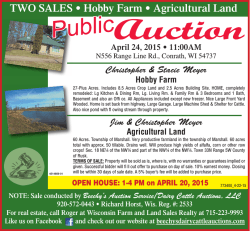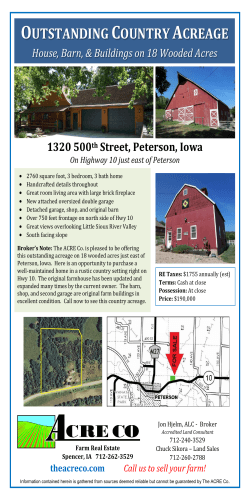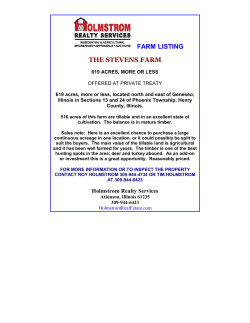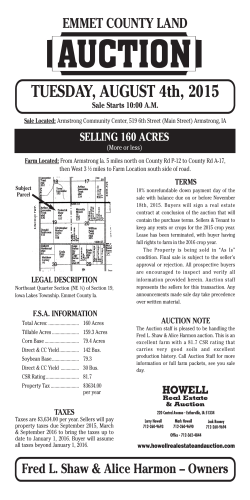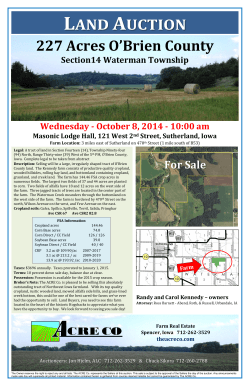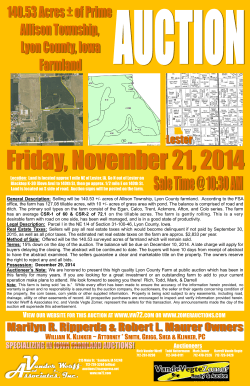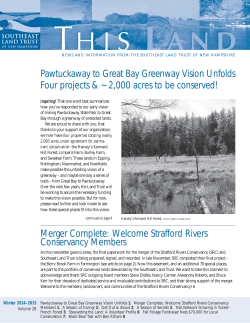
A Select History of North Olympic Land Trust 1990
A Select History of North Olympic Land Trust 1990-2015 1989 Searching for a solution: Craig Jacobs, then director of Clallam County Parks, talked with citizen volunteers on the Parks board about calls he’d gotten from property owners wanting to protect the habitat, resources and aesthetics that make their lands special. County Parks couldn’t afford to buy the land, so Jacobs asked Board members if they thought the growing land trust movement across the nation might be helpful. 1990 Getting organized: Attorney Gary Colley and some other County Parks Board members scheduled a public meeting. Citizens volunteering to follow up came from diverse backgrounds, including real estate, pulp mill administration and other local businesses. But all agreed a nonprofit organization might be valuable in protecting natural assets important to the area’s economy and ecology. Founding Board members elected Colley president. He led countless hours of work including securing nonprofit status, coming up with the North Olympic Land Trust name and obtaining a logo. (Local resident and graphic designer Kelsey Redlin donated the logo the organization used from 1999 through 2014). The volunteers appreciated getting help from Jefferson Land Trust, organized a year earlier. (Photo: Robbie Mantooth) 1993 First land donation: North Olympic Land Trust leaders worked hard, but it took three years before they had any land to protect. With the gift of Dungeness Meadows, 29 acres along the Dungeness River, the organization’s goals seemed on their way to becoming reality. 1995 First conservation easement: John Willits, a Peninsula College forestry professor, donated development rights on the 42-acre Quacker Farm. That generous action permanently protects exceptional waterfowl habitat near the mouth of the Dungeness River. Conservation easements are a valuable legal tool enabling landowners to own, use, sell and bequeath their property with assurance that the conservation values they love, which also provide public benefits, always will be there for present and future generations. (Photo: John Willits) 1995-1998 Growing popularity: As Gary Colley, John Willits and other volunteers shared their enthusiasm for win-win agreements with North Olympic Land Trust, more landowners completed conservation easements, donating specified development rights. Legal documents that always will accompany property titles list permitted and prohibited uses. Among the first property owners trusting the new nonprofit organization would make sure agreements would be upheld in perpetuity were Karl and Marie Greubel, especially eager to protect important bird, fish and other wildlife habitat along Salt Creek; Pete and Carolyn Schroeder, with property along the Dungeness River; Harry Lydiard, wanting trees he was planting on a 124-acre farm to be managed as sustainable commercial timber; Jim and Robbie Mantooth, passionate about providing good habitat for salmon in Ennis Creek and other wildlife in the stream corridor; and Willits, leasing 35 acres to Nash Huber for his organic farming operation. 1998 First grant: A state salmon recovery grant brought a big boost for buying development rights along the Dungeness River. Pete Schroeder likes to reminisce about knocking on doors of property owners along the river and telling them about opportunities to help protect the riparian corridor. Over the next two years the Land Trust protected 127 acres along the Dungeness River through voluntary agreements on eight properties. Today the organization protects 1.5 miles on 183 acres along the river for salmon and other wildlife habitat. (Photo: Lindsey Aspelund) 1999 Working forests: Harry Lydiard’s conservation easements on lands west of Port Angeles assured that trees planted in just about every minute the veterinarian and two-term County Commissioner could manage eventually would be harvested in compliance with forest management plans and then replaced with new trees. Before long timberland the Land Trust protects for sustainable harvesting reached nearly 200 acres, all in conservation easements Lydiard donated. Today, the Land Trust protects more than 460 acres of working forests, recognizing the importance of trees in the area’s economy, ecosystems and scenery. 2001 Partnerships: North Olympic Land Trust increased its land protection effectiveness through partnering with Clallam County, which provided funds from a $1 million state grant to help the organization protect 826 acres along local shorelines over the next 13 years. Continued collaboration with the County and other governmental entities, including Clallam Conservation District and area tribes, enables the Land Trust to protect natural assets as economically as possible. Partnerships with other organizations, businesses and individuals also are essential. 2001 Seeds for exceptional harvest: Sequim area residents helped create Friends of the Fields, focusing on protecting farmland in the fertile but flat and easily developed Dungeness Valley. The Friends raised funds and purchased a 30-acre farm, then worked with the Land Trust to establish a conservation easement before selling the land to farmers. Relationships between the two organizations continued to develop, leading to a merger in 2010 and a more productive “harvest” of farmland protection. 2002 Community outreach: Many people learned about the Land Trust during the dozen years Jim and Robbie Mantooth invited the public to come to StreamFest on their Ennis Arbor Farm conservation easement, centrally located in the Port Angeles area. The event offered local foods, walks through the forest and to Ennis Creek, and opportunities to learn how to help protect natural assets and raise money for Land Trust work. As support kept growing through the years, the organization was able to staff an office with professionals, a longtime dream of Board members and other volunteers after years of hiring part-time help and making do with space a generous supporter let them share in his office. As one Land Trust leader said, “Land Trusts take on legal responsibilities to uphold agreements and protect lands forever. The only way we can do that is to fund professional staff and our own office.” Although staff members handle many other responsibilities, they and volunteers also put priority on enabling the public to learn what the Land Trust is doing so they can support it with their time and financial resources. (Streamfest Poster: Karen Long, Jim and Robbie Mantooth) 2004 Volunteer work: Land Trust volunteers work with staff to plant trees and native plants, remove noxious weeds, and build trails for public use. Work so far has focused on properties the organization owns and opens to the public: Siebert Creek, east of Port Angeles; Elk Creek, on the edge of Forks; and Pysht River, west of Port Angeles. The Lyre Conservation Area land, acquired at the end of 2014, soon will benefit from such attention. Volunteers also help staff members during annual visits to conservation easements, helping landowners make sure terms of their agreements are being upheld. (Photo: Staff) 2007 Historic Bell Farm: Harry Lydiard often talked about the satisfaction of knowing the trees he’d planted and land he loved would benefit from his legal agreements with the Land Trust. But he said he found even greater delight when he bought 40 acres of the historic Bell Farm in the fertile Dungeness Valley and made sure it always would be available for agriculture through a conservation easement with the Land Trust. John Willits bought the farm’s other 40 acres and donated another agricultural conservation easement. Lydiard’s heirs continue the partnership their visionary father established with the Land Trust, protecting a total of 325 acres on five properties. 2009 Helping hold onto heritage: Through an agreement with the Land Trust, Jeff and Debbie Brown protected more than their 38-acre Dungeness Valley Creamery farm. They also made it possible for daughter, Sarah, and her husband, Ryan McCarthey, to take ownership and keep the dairy farm going. The Land Trust’s purchase of development rights, with help from state and federal grants, protects Clallam County heritage. Dungeness Valley Creamery is one of only two dairies left in a County that once boasted 500, noted for prizewinning products. (Photo: Staff) 2009 Moving west: The 255-acre Elk Creek Conservation Area is one example of the Land Trust’s commitment to the North Olympic Peninsula beyond the organization’s origins closer to Port Angeles. Located at the edge of the City of Forks, it provides popular hiking, wildlife watching and other tranquil recreational experiences for residents and tourists in western Clallam County. Elk Creek contains important salmon habitat, including spawning grounds for a third of the Coho salmon in the Calawah watershed. The Calawah River is a 31-mile tributary of the storied Bogachiel River, considered a fishing paradise. (Photo: Lindsey Aspelund) 2010 Merged for more benefits: Moving along from the official 2010 merger date, Board members and other volunteers of Friends of the Fields and North Olympic Land Trust pool talents, experience and energy, enabling the single, strengthened organization to protect more land for present and future generations. 2010 Forestry stewardship: Cal Thomas, owner of the 160-acre Blue Mountain Tree Farm, likes knowing the Land Trust will continue his work of keeping his family land productive as timberland and wildlife habitat. The organization’s stewardship of more than 460 acres of working forests through conservation easements continues an important element of Clallam County’s heritage and future responsible forestry. 2010 Restoration: Opportunities for the Land Trust to purchase properties like the Pysht River Conservation Area bring responsibilities for restoration. This land needed extensive noxious weed removal and replanting with native vegetation, enhancing the area’s habitat for a variety of salmonid species and other wildlife. The Makah Tribe helped with this project. The Lower Elwha Klallam Tribe and Jamestown S’Klallam Tribe also have helped with restoration on other properties the Land Trust protects. (Photo: David Woodcock) 2011 Patience: Friends of the Fields began working with the Jarvis family in 2007, several years before the organization’s merger with North Olympic Land Trust in 2010. It took more years before purchase of development rights and a conservation easement were complete. Many hours go into making sure agreements are tailored to landowners’ wishes and public benefits. But the payoff is enormous. The conservation easement that protects 61-acre Finn Hill Farm helps the family that has farmed some of the land for nearly a century and any future owners continue making the land productive. This farm also protects beautiful rural views. 2012 Highest status: North Olympic Land Trust earned accreditation from the Land Trust Alliance, one of the first 158 land trusts of 1,700 in the United States to gain this elite status. 2012-2014 More milestones: Today, Executive Director Tom Sanford heads a staff of four fulltime, experienced professionals whose expertise and energy enable them to work with landowners, partner organizations, volunteers and the public. By completing a conservation easement on Jane’s Farm, in the Dungeness Valley, the Willits family honored a sister and continued inspiring others. A standing ovation expressed appreciation to John Willits when he received the Land Trust’s first Gary Colley Legacy Award. Nash’s Organic Produce farms most of the Willits land, and owners Nash and Patty Huber bought another farm the Land Trust protected with a conservation easement, making the purchase price more affordable for farming. 2014 Biggest yet: Lyre River Conservation Area, the Land Trust's largest land acquisition to date, protects 280 acres of upland and riparian forest including Nelson Creek, the Lyre River estuary and a half mile of coastline. 2014 New Look, New Logo: Thanks to a grant from the Land Trust Alliance Excellence Program, the Land Trust updated its looks in 2014. Laurel Black Design of Port Angeles designed an updated logo and brand. Beans n’ Rice Creative Studios of Seattle designed a new website and helped grow the brand into a suite of new materials. 2015 and on Reason to celebrate: As the chart below shows, an organization that began because citizens asked the County to help protect special lands is achieving successes beyond what its founders might have imagined. The new logo Laurel Black designed celebrates priorities of the combined organizations – North Olympic Land Trust and Friends of the Fields – in protecting farms, fish and forests. The Land Trust's first 25 years is just the blink of an eye for an organization established to protect special lands forever. But the accomplishments its volunteers, staff, property owners, partners and other supporters already have made possible point toward a future that will benefit North Olympic Peninsula residents and visitors as well as others in the world beyond. Click here to see the names of Board members who have been part of the first 25 years as well as current committee members and other volunteers, partners and supporters. It isn't possible to list everyone who deserves thanks, but we hope these selected examples will provide inspiration for the years ahead. Conserved Acres 3,000 2,500 2,000 1,500 1,000 500 0 For a complete list of the 85 protected properties on 3,086 acres, click here.
© Copyright 2026
